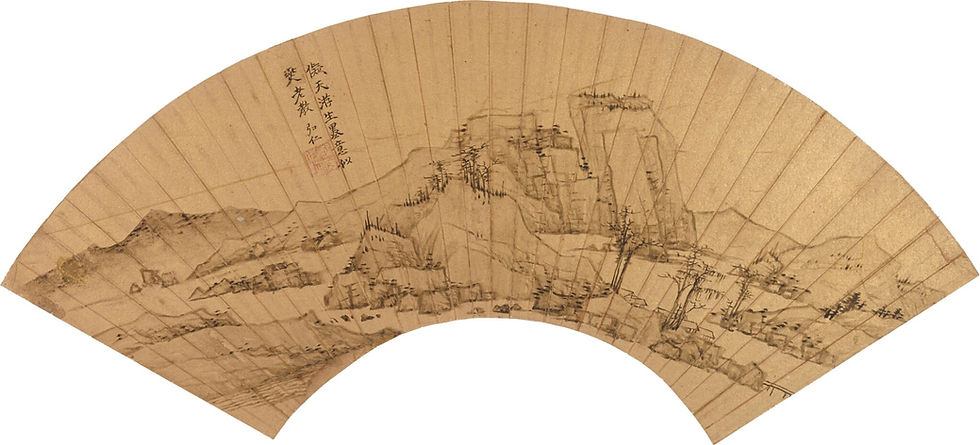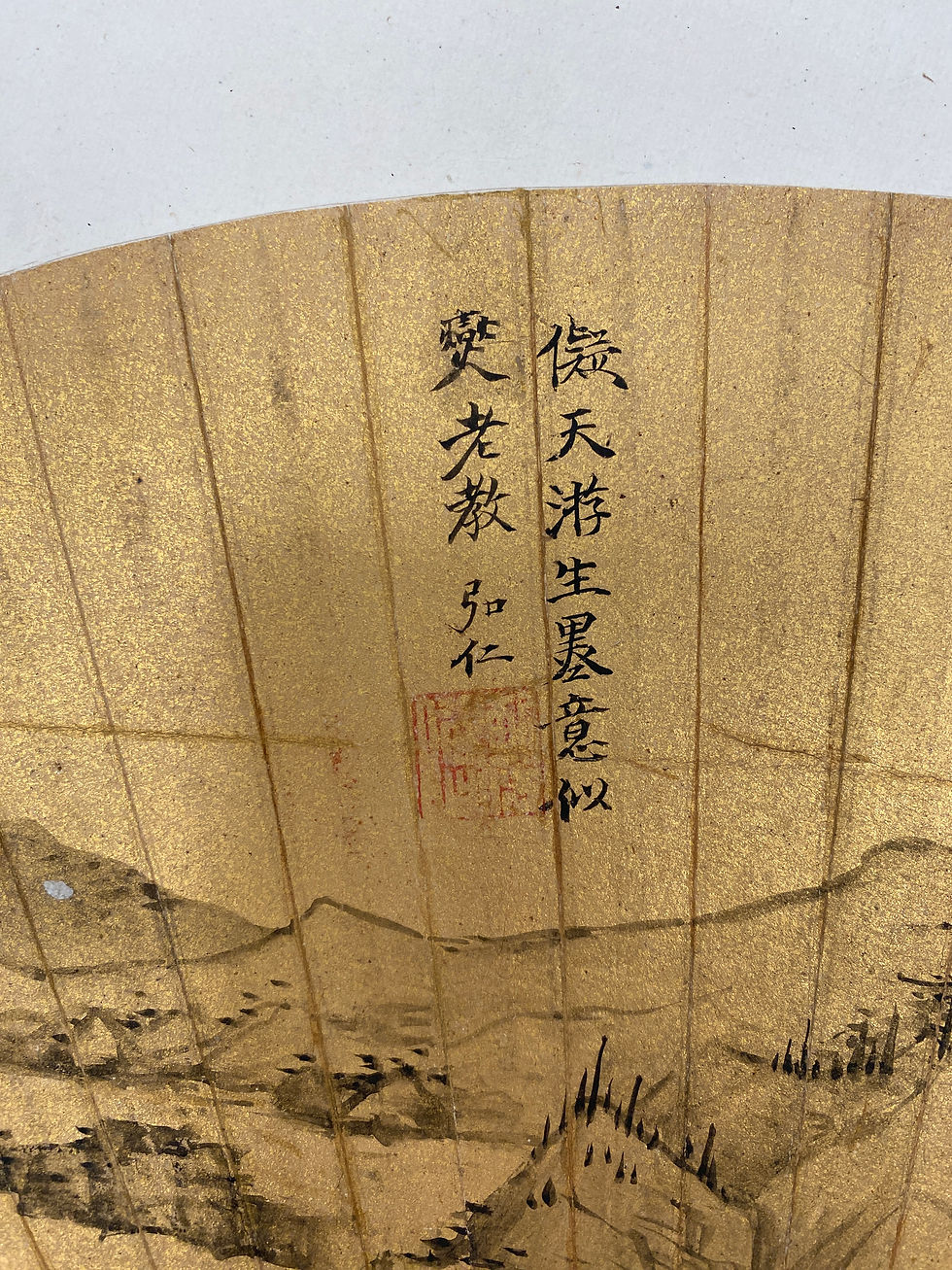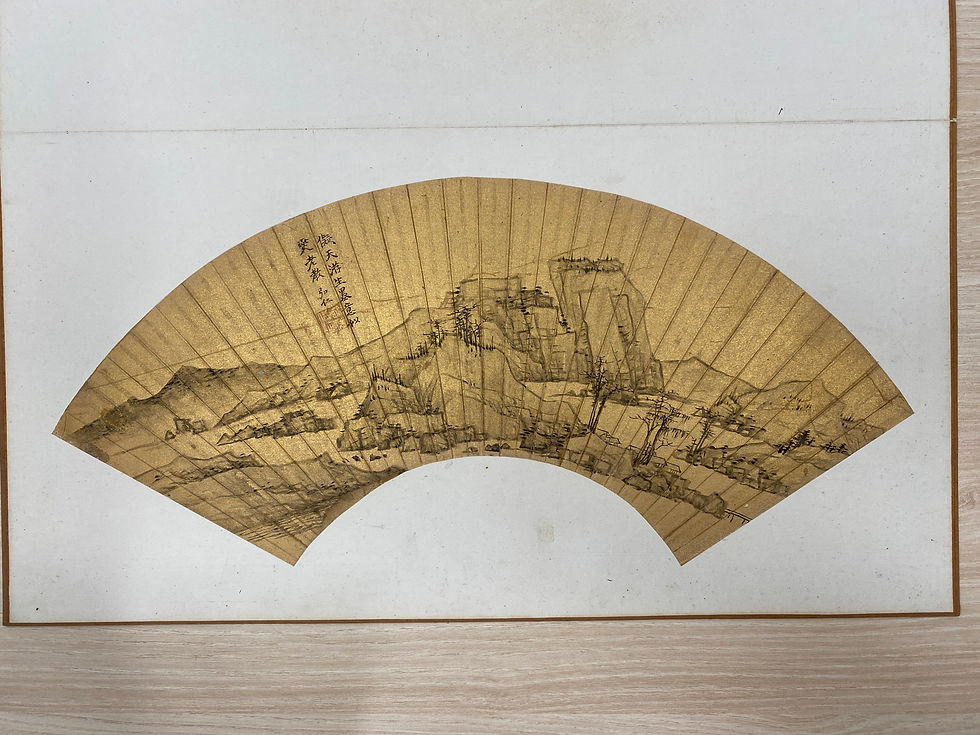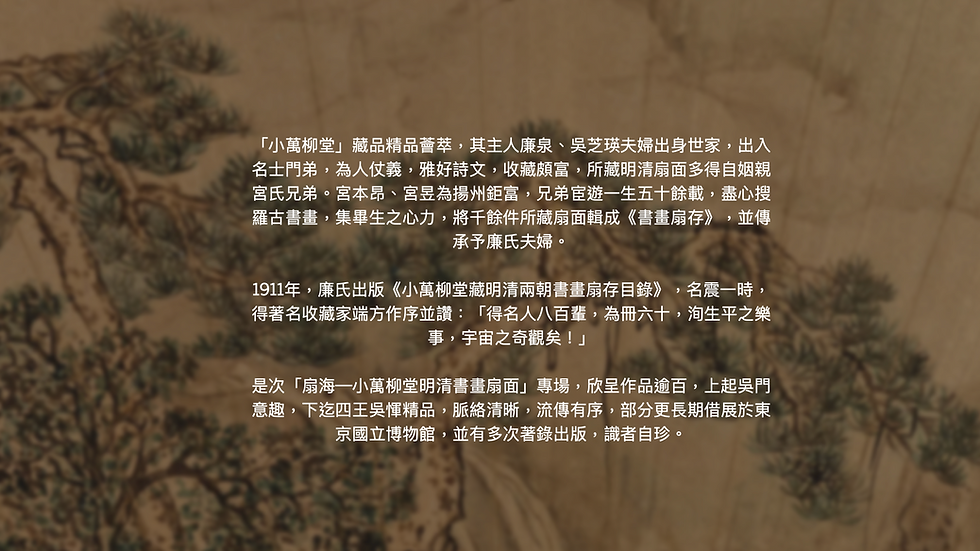書畫筆記 vol.4 小萬柳堂:504万港元弘仁擬陸廣山水 - Hongren, Landscape after Lu Guang
- SACA
- Oct 16, 2024
- 11 min read
Updated: Oct 17, 2024
504万港元成交,竞争激烈无比。
弘仁 1610-1664
擬陸廣山水
水墨金箋 扇面
款識:儗天游生墨意,似燮老教。弘仁。鈐印:漸江僧
16.6 x 51.4 cm. 6 ½ x 20 ¼ in.
1. 《名人書畫扇集》,第五十九,上海文明書局,1914,頁5
2. 《扇面大觀》,第四集,廉氏小萬柳堂,1911,頁54
著錄
《小萬柳堂明清兩朝書畫扇存目錄》,六集己冊,頁六十,見《歷代書畫續編》,第十四冊,國家圖書館出版,2010,頁523
Estimate
300,000 - 600,000 HKD
Lot Sold
5,040,000 HKD
Description
Hongren 1610-1664
Landscape after Lu Guang
ink on gold paper, fan leaf
signed Hongren, with a dedication and with one seal of the artist
16.6 x 51.4 cm. 6 ½ x 20 ¼ in.
小萬柳堂明清書畫扇面
中國自古用扇起源已不可考。扇子除搧風納涼外,更是文人雅士間特有的社交媒介。他們於扇面上作畫題字,互相饋贈。自明清以降,達官貴族、文人仕女無不以展示手中名家所畫之扇為雅事。扇子逐漸發展成為一種獨立的書畫作品形式,不僅具有收藏價值,亦紀錄了官宧文士間的交流往來。然而摺扇保存不易,藏家為求保存更常見將其拆裱成扇面收藏。
在民間收藏中,以「小萬柳堂」所藏之明清扇面最廣為人知。小萬柳堂是清末著名收藏家廉泉、吳芝瑛夫婦的堂號。廉泉,字惠卿,號南湖居士、小萬柳堂居士、扁笑、岫雲、世外人、江蘇無錫人,乃元朝大臣廉希憲的後憲。廉希憲曾在京師外修建別墅「萬柳堂」,廉泉故將自己於上海與杭州的住所為命名為小萬柳堂,自號小萬柳堂居士,緬懷祖德。他的夫人吳芝瑛是桐城學派大家吳綸的女,亦是著名的書法家、教育家與慈善家。
小萬柳堂書畫藏品早期以碑帖法書為主,後以扇面收藏聞名於世。清末收藏家端方曾評論他的收藏:「上自前明王孟端、張懿簡、王文成,以迄國初乾嘉諸老,得名人八百輩,為冊六十,洵生平之樂事,宇宙之奇觀矣。」,可知其收藏之豐。廉氏的扇面藏品主要得自姻戚宮本昂、宮昱兄弟舊藏。
宮本昂,字子行,紫珩,號千里,室名延蝶仙館,江蘇泰縣人,曾任山東知縣,其弟宮昱,字玉甫,玉父,曾任直隸知州。於數十年的仕宧生涯其間,宮氏兄弟除與晚清名臣曾國藩、李鴻章等晚清名臣交游外,亦與金石書畫鑒藏名家王懿榮、羅振玉、陳介祺等來往。據《小萬柳堂藏畫記》記述,宮氏兄弟畢生所藏扇面共一千零五十三開,集明清名家書畫作品大成。宮本昂病革時,囑其妻孫婉如將《明清兩朝名人書畫扇存》所載之封存於十二篋內,歿後售予廉泉。
廉泉一生曾六次訪日。1914年,廉泉應日本駐中國大使山座圓次郎邀請,首次以民間學者身份攜同小萬柳堂書畫收藏前往日本,參加東京大正博覽會,在日華質易館的貴賓室展出。展覽引來社會名流爭相觀展、媒體競相報導,一時轟動。在博覽會上,他與日本文化界名流如學者內藤湖南、東京美術學校教授大村西崖等結為好友,共同推動中國文人畫在日本的交流與發展,促進中國藝術在日本的傳播。廉泉在多次訪日期間,曾應邀攜同藏品於東京美術學校和京都大學展出,甚至用作京都大學演講會的教材。此外,他還在神戶及東京開辦扇面美術館,輪流展出他的扇面藏品,並出版《扇面大觀》四冊。
1911年,正值社會動亂時期,為保存藏品免遭掠奪,廉泉夫婦將其委托給友人華北協和女子大學校長麥美德(S. Luella Miner)保管。之後,為報答她的恩情,廉泉夫婦計劃在日本出售藏品,並將大部分資金當作慈善基金捐贈給華北協和女子大學,同時籌集資金用作照顧宮氏後人。在十年間他的多次中日往返中,廉泉陸續出售了一部分書畫藏品,如現藏於大阪市立美術館的阿部房次郎藏倪瓚《溪亭秋色圖》、王蒙《江皋煙嵐圖卷》、石濤《東坡時序詩意圖冊》等。然而,對於扇面藏品,儘管近藤廉平、神戶市長小寺謙吉、阿部房次郎等人都曾表示收購意向,但由於種種原因一直未能成交。根據1925年出版的《東洋美術史》(大村西崖撰),整批扇面最終售予長崎橋本商會的第二代社長橋本辰二郎。1952年,日本著名企業家小阪順造(圖一)購得整批藏品。
小坂順造(1881-1960)多年來出任眾多企業重要職務,1904年,他在日本銀行任職,1908年出任信濃銀行董事(即現瑞穗銀行)。1911年,他成為信濃每日新聞社社長。1923年至1930年間,他先後擔任長野商會會長、長野電氣及信越氨肥料公司總裁。1940年,他擔任電力企業管理委員主席。1912年,他當選眾議院議員,並對於日本社會作出重要貢獻,1960年歿後被追授勳一等旭日大绶章。小坂順造多年來致力於資助藝術發展,尤其對中國書畫情有獨鍾。他的兒子小坂善太郎(1912-2000)亦是中日文化交流的推手。小坂善太郎從政多年,自1946年當選眾議員,及後於1960年擔任外務大臣,1972年任自民黨日中邦交正常代協議會長,多年來積極促進中日邦交。
小萬柳堂書畫扇面從中國到日本,歷經多次展覽出版,除了是二十世紀初中日文化交流的見證,更為中日學者研究中國藝術提供了重要的史料基礎。本輯精選了其中百餘幅扇面,囊括了明清兩代名家精品。上至吳門文人意趣,下迄四王吳惲精品,脈絡清晰,流傳有序,全面展現整個明清兩代書畫發展的脈絡。
THE MING AND QING DYNASTY FAN PAINTINGS OF XIAOWANLIUTANG
In China, the origin of fans and its usage is untraceable.
Beyond a utilitarian purpose for cooling, fans also served as a unique medium for social exchange among the literati who would paint and write on fan leaves and exchange them as gifts. During the Ming and Qing dynasties, it became a sophisticated trend among the nobility and literati to showcase fans painted by renowned artists. Over time, the fan evolved into an independent form of art, valuable not only for its aesthetic appeal but also for the recording of social exchanges among scholars and officials. However, the preservation of folding fans poses many challenges, so collectors often unmount them into flat fan leaves for better safeguarding.
Of fan paintings in private hands, those in the collection of Xiaowanliutang are among the most widely recognised.
Xiaowanliutang is the studio name of prominent late Qing dynasty collectors Lian Quanand his wife Wu Zhiying. Lian Quan (1868-1931), styled Huiqing, was also known by several pseudonyms such as Nanhu Jushi, Xiaowanliutang Jushi, Pianxiao, Xiuyun, Shiwairen. He was a native of Wuxi, Jiangsu, and a descendant of Yuan dynasty official Lian Xixian. Lian Xixian had once built a villa called Wanliutang outside Beijing. To honour his ancestor, Lian named his residences in Shanghai and Hangzhou Xiaowanliutang and adopted the title Xiaowanliutang Jushi. His wife Wu Zhiying was the niece of Wu Rulun, a leading figure of the Tongcheng school. She was also recognised as a noted calligrapher, educator, and philanthropist in her own right.
The Xiaowanliutang collection initially focused on stele rubbings and calligraphy, but later became highly regarded for its fan paintings. Reflecting on the richness of the collection, the late Qing dynasty collector Duanfang once praised Lian's collection: "From the great masters of the late Ming such as Wang Mengduan, Zhang Yijian, Wang Wencheng, to the scholars of the early Qing period like Qianjia, the collection encompasses works by more than 800 masters, compiled into 60 volumes - a remarkable accomplishment and a rare sight in the world." Lian's fan leaves were primarily obtained from the collections of his relatives, brothers Gong Benang and Gong Yu.
Gong Benang, styled Zihang and Ziheng, was also known as Qianli. He was from Taixian, Jiangsu, and served as a county magistrate in Shandong. His brother, Gong Yu, styled Yufu, served as a prefect in Zhili. During their official careers, the brothers associated with prominent late Qing officials such as Zeng Guofan and Li Hongzhang, as well as notable art collectors and connoisseurs including Wang Yirong, Luo Zhenyu, and Chen Jieqi. According to the Xiaowanliutang Collection of Paintings, the brothers compiled a comprehensive collection of Ming and Qing dynasty masterpieces comprising 1,053 fan leaves. On his deathbed, Gong Benang instructed his wife Sun Wanru to seal the collection, then known as Ming and Qing Famous Paintings and Calligraphy Fans, in twelve chests and to sell them to Lian upon his passing.
Over the course of his life, Lian Quan visited Japan six times.
In 1914, at the invitation of Yamaza Enjiro, the Japanese ambassador to China, Lian brought his collection of paintings to Japan to participate in the Tokyo Taisho Exposition.
Xiaowanliutang was displayed in the VIP room of the Chinese pavilion, attracting widespread attention from the Japanese elite and drawing extensive media coverage. At the exposition, Lian made friends with prominent figures in Japanese culture, such as scholar Naitõ Konan and Tokyo Fine Arts School professor Omura Seigai. Together, they promoted the exchange and development of Chinese literati paintings in Japan, facilitating the spread of Chinese art in the country. During his many visits to Japan, Lian was invited to exhibit his collection at the Tokyo Fine Arts School and Kyoto University, and at the latter, his collection even served as teaching material for lectures. Additionally, Lian established museums of fan painting in Kobe and Tokyo, rotating the display of his fan leaves and publishing four volumes of The Grand View of Fan Paintings.
In 1911, during a period of social unrest, Lian and his wife entrusted the safekeeping of their collection to their friend, Dr. S. Luella Miner, president of North China Union College for Women. Later, to express their gratitude, the couple made plans to sell the collection in Japan and donate most of the funds as a charitable foundation to North China Union College for Women, while also raising money to support the descendants of the Gong family. Over a decade of travels between China and Japan, Lian gradually sold part of his painting collection, such as Ni Zan's Autumn Scenery of the Stream Pavilion, Wang Meng's Riverside Smoke and Mist, and Shi Tao's Poetry Inspired by Su Dongpo - all of which are now housed in the Abe Collection at Osaka City Museum of Fine Arts. However, due to various reasons, a sale of the fan collection was not finalised despite the interest of buyers such as Kondõ Repei, Kobe Mayor Kodera Kenkichi, and Fusajiro Abe. According to Omura Seigai's History of Eastern Art published in 1925, the entire collection was eventually sold to Hashimoto Tatsujiro, the second-generation president of Nagasaki Hashimoto Shokai. In 1952, the famous Japanese entrepreneur Junzo Kosaka (fig.1) acquired the collection.
Throughout his career, Junzo Kosaka (1881-1960) held several prominent positions in various. In 1904, he worked at the Bank of Japan and in 1908 became a Director of Shinano Bank (now Mizuho Bank). In 1911, he became the President of Shinano Mainichi Shimbun. Between 1923 and 1930, he served as the chairman of Nagano Commerce, the president of Nagano Electric and Shin-Etsu Nitrogen Fertilizer Company. In 1940, he chaired the Power Enterprise Management Committee. In 1912, he was elected to the House of Representatives and made significant contributions to Japanese society, In 1960, he was posthumously awarded the Order of the Rising Sun, First Class.
Kosaka was deeply committed to supporting the arts, with a particular passion for Chinese painting and calligraphy.
His son, Zentaro Kosaka (1912-2000), also played a significant role in promoting cultural exchange between Japan and China. Zentaro served as a member of the House of Representatives from 1946 and later as Minister for Foreign Affairs in 1960. In 1972, he became the chairman of the Liberal Democratic Party's Japan-China Diplomatic Normalization Agreement, working for many years to strengthen diplomatic ties between Japan and China.
This collection of Ming and Qing fan leaves from the Xiaowanliutang collection traveled from China to Japan, undergoing several exhibitions and publications. This collection not only serves as a testament to early 20th-century cultural exchanges between China and Japan but also provides essential historical material for scholars studying Chinese art. In this auction, we carefully select over a hundred fan paintings and calligraphy, featuring masterpieces from the Ming and Qing dynasties. The selection ranges from the literary elegance of the Wu School to the refined works of the Orthodox School, offering a comprehensive overview of the development of painting and calligraphy during the Ming and Qing dynasties.
The Xiaowanliutang Collection: Frequently Asked Questions
1. What is the Xiaowanliutang Collection?
The Xiaowanliutang collection is a renowned collection of Chinese fan paintings primarily from the Ming and Qing dynasties. It's named after "Xiaowanliutang", the studio name of its most famous owners, Lian Quan and his wife Wu Zhiying, prominent late Qing dynasty collectors.
2. What is special about fan paintings as an art form?
Fan paintings are unique because they represent not just art, but social customs and intellectual exchange. During the Ming and Qing dynasties, painting and writing on fans and gifting them was a popular practice among the literati. The fan itself became an object of beauty and a symbol of refined taste.
3. How did the Xiaowanliutang collection come to be so famous?
The collection's fame is rooted in both its size and quality. It boasts over 1,053 fan leaves, featuring works by over 800 renowned artists, making it a comprehensive representation of Ming and Qing dynasty art. The collection’s impressive lineage, passing through the hands of notable collectors, further adds to its prestige.
4. How did the collection end up in Japan?
Lian Quan, in efforts to preserve the collection during times of unrest in China and to support charitable causes, made the decision to sell the collection in Japan. After being exhibited and attracting considerable interest, it was ultimately purchased by Japanese entrepreneur Junzo Kosaka in 1952.
5. Who were some of the key figures involved in the collection's journey?
Besides Lian Quan and his wife Wu Zhiying, key figures include:
Gong Benang and Gong Yu: The brothers who originally assembled the core of the fan painting collection.
Duanfang: A late Qing dynasty collector who praised the collection's quality and scope.
Dr. S. Luella Miner: President of North China Union College for Women who safeguarded the collection during unrest.
Hashimoto Tatsujiro: The Japanese businessman who initially purchased the collection from Lian Quan.
Junzo Kosaka: The Japanese entrepreneur and art patron who ultimately acquired the entire collection.
Zentaro Kosaka (Junzo’s son): A figure who contributed to cultural exchange between Japan and China.
6. What is the significance of the Xiaowanliutang collection beyond its artistic value?
The collection transcends mere artistic value. It serves as a tangible record of the cultural and intellectual exchange between China and Japan in the early 20th century. Its journey from China to Japan highlights the interconnectedness of art appreciation and collecting practices across nations.
7. How did the collection contribute to the study of Chinese art?
The Xiaowanliutang collection has been extensively exhibited and documented, offering valuable insights into the evolution of Chinese painting styles during the Ming and Qing dynasties. It provides researchers with a well-preserved and comprehensive resource to study artistic techniques, trends, and the social context of fan painting.
8. Is the collection still accessible to the public?
While the entire collection isn't permanently on display, selections from the Xiaowanliutang collection are featured in exhibitions and auctions, allowing the public to appreciate these significant pieces of Chinese art history.
The Xiaowanliutang fan collection is historically significant for several reasons:
The collection is renowned for its comprehensive representation of Ming and Qing dynasty masterpieces. It comprises 1,053 fan leaves featuring works by over 800 artists from these periods, making it a valuable resource for scholars studying Chinese art.
●
The collection played a pivotal role in early 20th-century cultural exchanges between China and Japan. Lian Quan, the owner of the Xiaowanliutang collection, exhibited the collection in Japan multiple times, fostering the spread of Chinese art in the country.
●
The journey of the collection reflects the social and political dynamics of the time. It was initially entrusted to a friend for safekeeping during social unrest in China and later sold to Japanese collectors.5 This transfer of ownership highlights the complexities of cultural heritage preservation during times of upheaval.
The collection's historical significance is further enriched by the individuals involved in its creation and preservation:
●
Lian Quan and Wu Zhiying: Lian Quan, a descendant of a Yuan dynasty official, and his wife, Wu Zhiying, a renowned calligrapher, meticulously assembled the Xiaowanliutang collection, demonstrating their deep appreciation for Chinese art and culture.
●
Gong Benang and Gong Yu: The Gong brothers, who initially owned the fan collection, were prominent officials and art enthusiasts connected to influential figures of their time. Their careful curation of the collection laid the foundation for its later significance.
●
Japanese collectors and patrons: Individuals like Hashimoto Tatsujiro and Junzo Kosaka played a crucial role in preserving the collection in Japan, ensuring its availability for future generations.57 The engagement of figures like Zentaro Kosaka, a prominent advocate for Japan-China relations, highlights the collection's continued relevance in fostering cultural understanding between the two nations.
Overall, the Xiaowanliutang fan collection stands as a testament to the rich artistic traditions of China and its enduring impact on cultural exchange with Japan.

























ความคิดเห็น